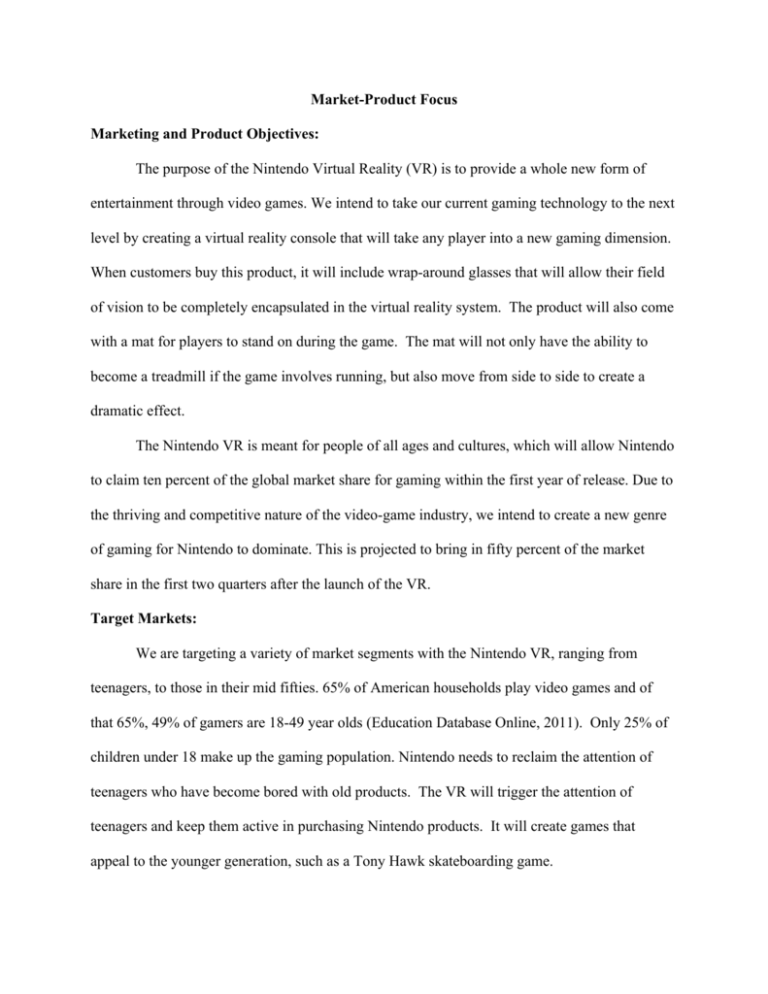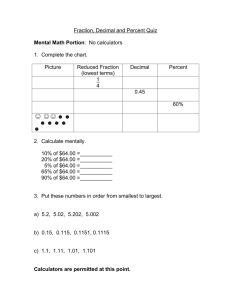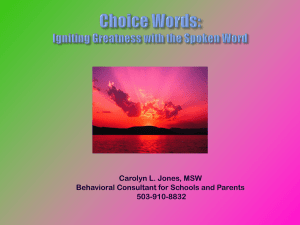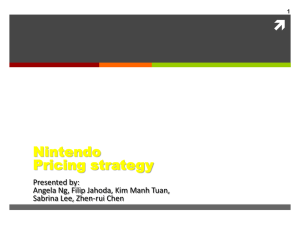Nintendo Marketing Plan
advertisement

Market-Product Focus Marketing and Product Objectives: The purpose of the Nintendo Virtual Reality (VR) is to provide a whole new form of entertainment through video games. We intend to take our current gaming technology to the next level by creating a virtual reality console that will take any player into a new gaming dimension. When customers buy this product, it will include wrap-around glasses that will allow their field of vision to be completely encapsulated in the virtual reality system. The product will also come with a mat for players to stand on during the game. The mat will not only have the ability to become a treadmill if the game involves running, but also move from side to side to create a dramatic effect. The Nintendo VR is meant for people of all ages and cultures, which will allow Nintendo to claim ten percent of the global market share for gaming within the first year of release. Due to the thriving and competitive nature of the video-game industry, we intend to create a new genre of gaming for Nintendo to dominate. This is projected to bring in fifty percent of the market share in the first two quarters after the launch of the VR. Target Markets: We are targeting a variety of market segments with the Nintendo VR, ranging from teenagers, to those in their mid fifties. 65% of American households play video games and of that 65%, 49% of gamers are 18-49 year olds (Education Database Online, 2011). Only 25% of children under 18 make up the gaming population. Nintendo needs to reclaim the attention of teenagers who have become bored with old products. The VR will trigger the attention of teenagers and keep them active in purchasing Nintendo products. It will create games that appeal to the younger generation, such as a Tony Hawk skateboarding game. 2 Twenty-six percent of people over 50 years old make up the gaming population, which is a higher percentage than gamers who are under 18 (Education Database Online, 2011). Those who are older have more money to invest into buying Nintendo’s products. It is Nintendo’s responsibility to make sure the older generation feels valued by creating games that appeal to them and their families. To appeal to this age group, Nintendo will create games such as the one under development called “Marathon.” Points of Difference: The Nintendo VR will be different than any gaming console currently on the market. • The Nintendo VR takes gamers to places that, previously, have only existed on a flat screen. Their imagination will be reality. The competitors’ products, the Xbox Kinect and the Playstation 3, will struggle to compete because they have not developed this application of technology. • Our product will have a straightforward design so people of all ages can easily use it. It is different from competing products because of the simple controls based off of the players’ movements. • The mat, which will come with the Nintendo VR, will have more features than other interfaces currently created for other video games. The advanced features, such as the ability for the mat to turn into a treadmill, will make the player feel like they are an active part of the game. Positioning Strategy There has been no new technology introduced into the market within the last few months, and because of that, the market is anxious to cling to a new and improved form of technological entertainment. Nintendo must position the Nintendo VR so that consumers will understand the 3 high-tech features of the system and have a desire to buy the product. To position our product to make it appealing to multiple age groups, we will need to join with other well-known companies, such as Disney, to attract customers. To appeal to preteens and teenagers, we will partner with Disney in creating games that involve the consumer interacting with their favorite Disney characters. For example, by this partnership, we will be able to make them feel like they are actually part of their favorite Disney show, such as the Phineas and Ferb. Partnering with Disney and other companies will allow our product to cross-market and attract customers. Nintendo will also utilize commercials on television to spread the word about the Nintendo VR. These commercials will focus on the concept that Nintendo wants to appeal to every member of the family. The commercial would begin with a child who is a teenager who is playing the Nintendo VR, and then would show each member of the family joining in to play. It is also important to emphasize that while other gaming systems are still using controllers and hard copy games, the Nintendo VR is hands-free, voice controlled, and will not require a disc as the games will be offered in a downloadable format from an online store. This technology will be so simple to use, which will allow it to bridge the technology gap between children and senior citizens. Marketing Program Product Strategy: The Nintendo VR will come in a sleek black box with a clear front so that customers can easily see all that is included. The box will include a pair of wrap around glasses and a high-tech mat. • Wrap-around glasses: This part of the system will allow for a player’s field of vision to be completely encapsulated in the virtual reality system. For a personal 4 touch, the consumer will have the option of customizing the appearance of their glasses. The face of the glasses easily snaps off, and customers can choose to buy clip-on covers that will be sold separately. For example, a teenage girl may want her glasses to be pink and glittery. • High-tech Mat: The player stands on a 3 feet by 2 feet mat while they are playing. The mat has light sensors that will be able to detect the moves of every part of the player’s body and feeds the information into the game. In addition, the mat not only becomes a treadmill, but also moves from side to side to compensate for movement and differing terrains. Depending on the type of game, the mat will perform different tasks to make the gamer feel as if they are inside the game. A second mat can be purchased if consumers want to compete with others in the same room or via the Internet with the system’s Wi-Fi capabilities. Listed below are just a couple of examples of the many games that we will offer: • Tony Hawk Skateboarding: The target is a teenager. They will have to keep their balance on the mat and learn to jump at the right times, therefore developing coordination skills. They will feel like they are physically at a skate park performing high-class moves on the rails without the chance of physical harm. • Marathon: The player will run on the mat through many locations, pump their legs to bike through towns, and move their arms to swim through oceans. The customer will have the option to purchase a five-year warranty for the low price of $20. This will give customers a sense of security about their purchase, knowing that it can be replaced if damages occur within that time period. The overall goal is to maintain Nintendo’s reputation of quality, to establish brand loyalty and to rebuild product awareness and interest. 5 When relating to our product development, we will invest most of our energies into idea generation and screening, concept testing, and product development. Our online gaming community that we will create for our consumers (please refer to “promotion strategy”) will provide a rich external idea source. We will also provide beta testing and developer’s information for VR users who want to pursue their own game ideas. We will be able to screen, test, and ultimately develop a more refined product for the company to put on the market. The Product Life Cycle (PLC) of the Nintendo VR will be an ongoing process. During the product development stage we will be cautious about every detail pertaining to our gaming system so that we can maximize our profits. Although the introduction stage is slow in sales growth, we believe that the specific venues we have chosen to promote and advertise the VR will effectively penetrate our market. Profits and sales will increase during the growth stage. Progressing into the maturation stage, most companies have problems maintaining positive sales growth. To overcome this, we will continue to provide new products at low prices. Lastly, the decline stage occurs when a product has reached its maximum output but is no longer increasing its sales. When we reach this point, we will resort to our exit strategy to most efficiently use our resources. Promotion Strategy: The promotion of the Nintendo VR will be clear and persuasive, informing customers about our product and what makes it unique. Amidst a digital and wireless age, marketing strategies are changing. To counteract this trend, we will integrate many forms of communications channels without blurring brand perceptions. Using integrated marketing communications, we will persuasively promote the sales of the Nintendo VR. 6 Through advertising, we manage to reach many geographic locations and build a long- term image. We are striving to make Nintendo’s image appeal to all ages. For this reason, Nintendo will utilize one main television commercial to spread the word about the Nintendo VR. This commercial will focus on the fact that the Nintendo VR is applicable for every member of the family. The commercial would begin with a teenager playing the Nintendo VR, and then show each member of the family joining in to play. Nintendo realizes that advertising is only a one-way form of communication and it can often lead to no response from the customer, therefore we will also utilize various forms of sales promotions. Nintendo members will receive monthly coupons with a two-day deadline to use them, therefore giving them a sense of urgency to buy the product. In addition we will ensure that a demo product is available for gamers to try in stores. A demonstration of the product and its abilities will help convince the customer to make a purchase. Our company will use the direct mail, catalog and Kiosk forms of marketing. Directmail marketing and catalog marketing will show all the products that we offer and upcoming new releases that will be available for purchase in store. By using these two forms of marketing we can assure that our customers are always up to date with everything we are doing. Using Kiosk marketing we can have demos set up throughout many stores. Most customers prefer to test something before buying, giving each customer a greater sense of knowledge about the product and pushes them to purchase even if they had been unsure before. We will also host a competition to see who can design the “next best Nintendo VR game.” Participants will post a YouTube video explaining their concept that will be judged by a panel of Nintendo game designers. Posting videos on YouTube will generate customer interaction and 7 create a “buzz marketing” effect. We will also give out a $5,000 scholarship each year to the person who writes the best essay on their interest in innovative computer programming. Public relations will be extremely important in order to have control over the image of our company and our product. We want to obtain favorable publicity, build a good corporate image and control unfavorable rumors. We will gain positive customer attention by sponsoring the National Health and Exercise Science Association. We agree with their mission to exercise often and we want to encourage people to exercise using the Nintendo VR. In response to the growing presence of social media in consumers' lives, we will also create an online gaming community for our gamers. Nintendo will host semi-regular VR tournaments that will challenge gamers in a variety of different downloadable teaser games. These downloadable teasers, available only during official VR tournaments, will not only serve as product testing, but also a promotion for new games about to hit the market. We will make our gaming community easy to access by posting links on our promotional material, website, Facebook, and Twitter. Although we are targeting all ages for the Nintendo VR, direct marketing will still be important. We need to be careful that our promotion strategy is specific enough that we do not lose focus of our primary market segment. Building off of our commercial concept, we will emphasize the fact that all members of a family can show interest in the product. Thus the focus of our promotion strategy is to persuade consumers to try our virtual reality system as a new form of gaming that anyone can enjoy. We must be interactive with our strategy, seeking to alter our plans based off customer responses. We plan to use both the push and pull strategies in our marketing mix. The “push strategy” is a business-to-business strategy where we will dedicate a portion of our budget. With 8 this strategy, we will focus solely on selling to retailers. We are aiming to push our product through this first channel, and then as a result, the retailers would push the VR to the next channel, the consumer. Since we are a business-to-customer company, we will spend most of our budget on the pull strategy where we will pass over the retailers and directly target our customers through advertising and other promotions. Our promotion objectives are to inform, persuade, and then remind the customer about our product. We will inform them about the Nintendo VR through advertising. With this advertising, our aim is to persuade customers, generate interest by having occasional sales, and remind them about our product by promoting Nintendo memberships. To ensure adequate promotion, we will use the objective-and-task method for developing our promotional budget. We will determine the tasks our advertising should accomplish to meet our objectives. Once these are decided, we will estimate the necessary expenses. We do not want to short our advertising budget because sales are in direct proportion to promotion. We will clearly present a message through only a few execution styles. We want to use the fantasy style because being a part of a virtual reality can most definitely make you feel like you are in a fantasy. Fantasy generates excitement, which correlates with our advertising goal. Incorporating the lifestyle style, we want to show how the Nintendo VR will be used for entertainment within the customer’s current lifestyle. 9 Bibliography All the world’s a game. (2011). Economist, 401(8763), 3-5. Business & company resource center. (2005). Retrieved from http://galenet.galegroup.com/servlet/BCRC?vrsn=unknown&locID=vic_liberty&srchtp= glbc&cc=1&c=2&mode=c&ste=74&tbst=tsCM&tab=4&ccmp=Nintendo Company Ltd.&mst=nintendo&n=25&docNum=I2501309329&bConts=13119 Console manufacturers. (2012, April 19). Retrieved from http://sites.duke.edu/soc142videogames/global-value-chain/major-players/console-manufacturers/microsoft/ DATAMONITOR: Nintendo Co., Ltd. (2011). Nintendo Co. Ltd. SWOT Analysis, 1-8 Education Database Online. (2011). www.onlineeducation.net. Retrieved from http://www.onlineeducation.net/videogame Huse, T. (2010, August 24). Retrieved from http://blogs.hbr.org/cs/2010/08/what_can_we_learn_from_ninten.html Microsoft. (2011, October 17). Retrieved from http://www.microsoft.com/about/companyinformation/ourbusinesses/en/us/business.aspx Nintendo. (2011). Corporate. Retrieved February 3, 2012 from http://www.nintendo.com/. Sony « The Video Game Industry. (n.d.). Duke WordPress | sites.duke.edu. Retrieved February 3, 2012, from http://sites.duke.edu/soc142-videogames/global-value-chain/majorplayers/console-manufacturers/sony-2/ Yahoo Finance. (2012, January 27). Retrieved from http://finance.yahoo.com/q/co?s=NTDOY.PK+Competitors



